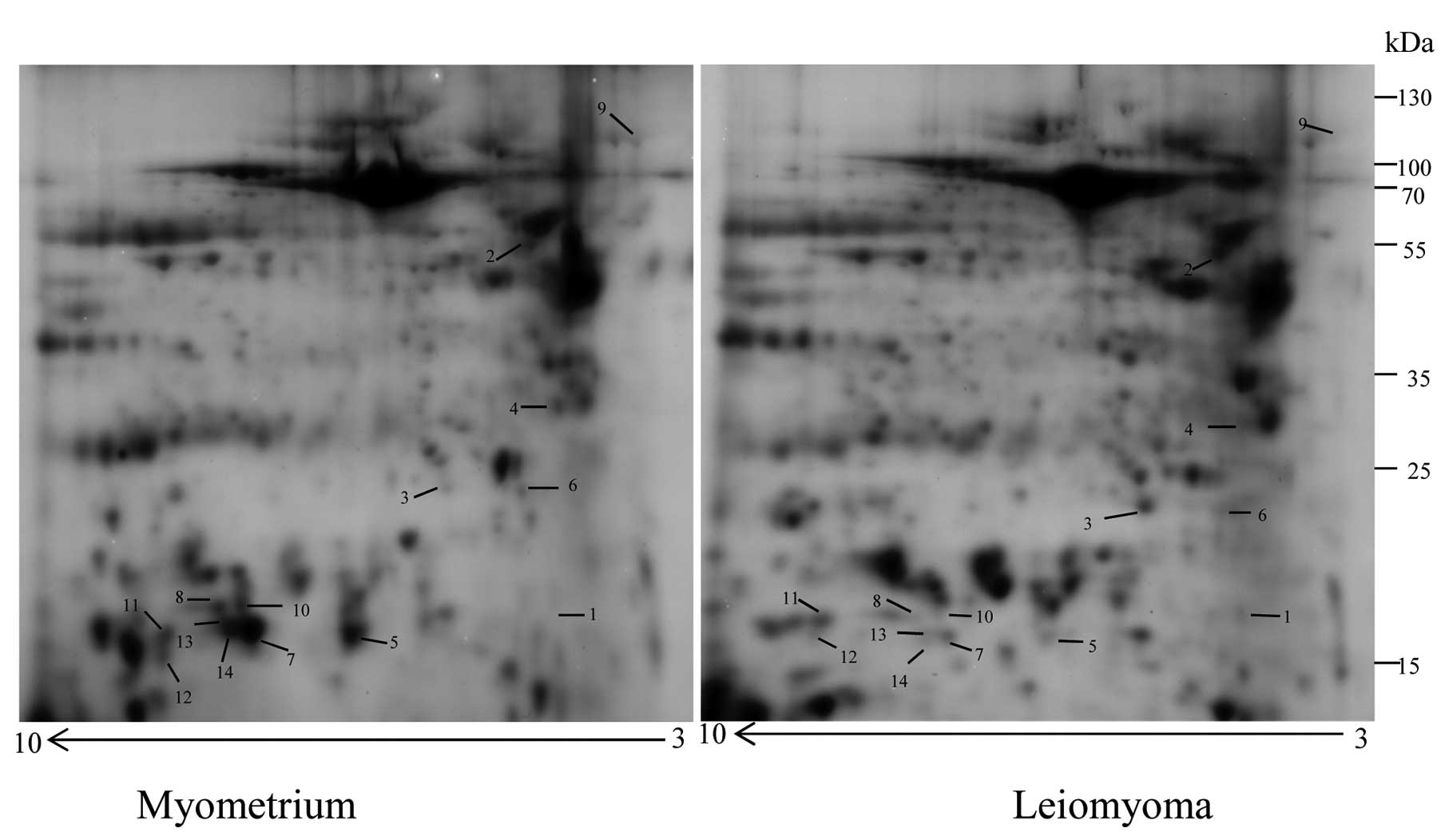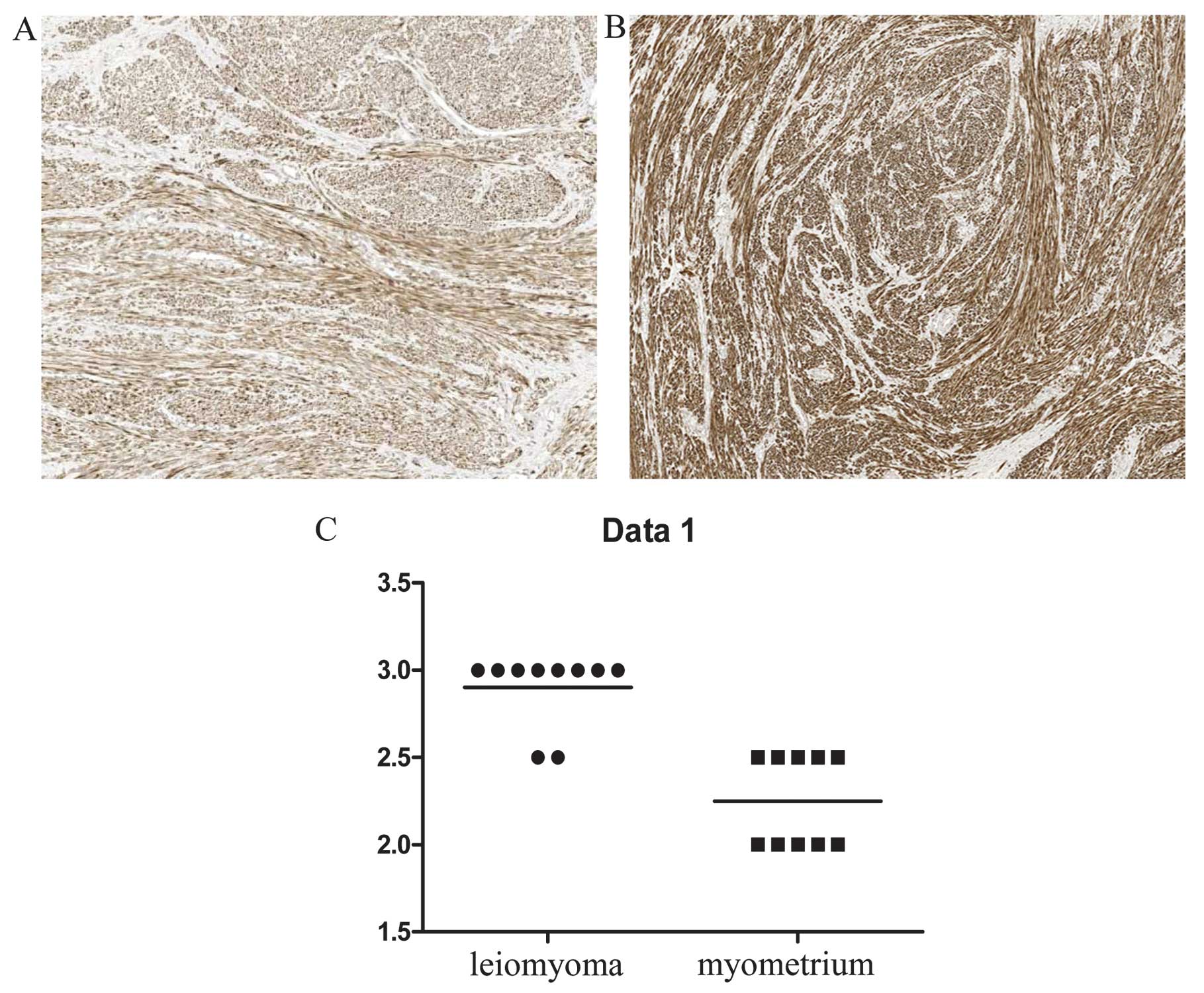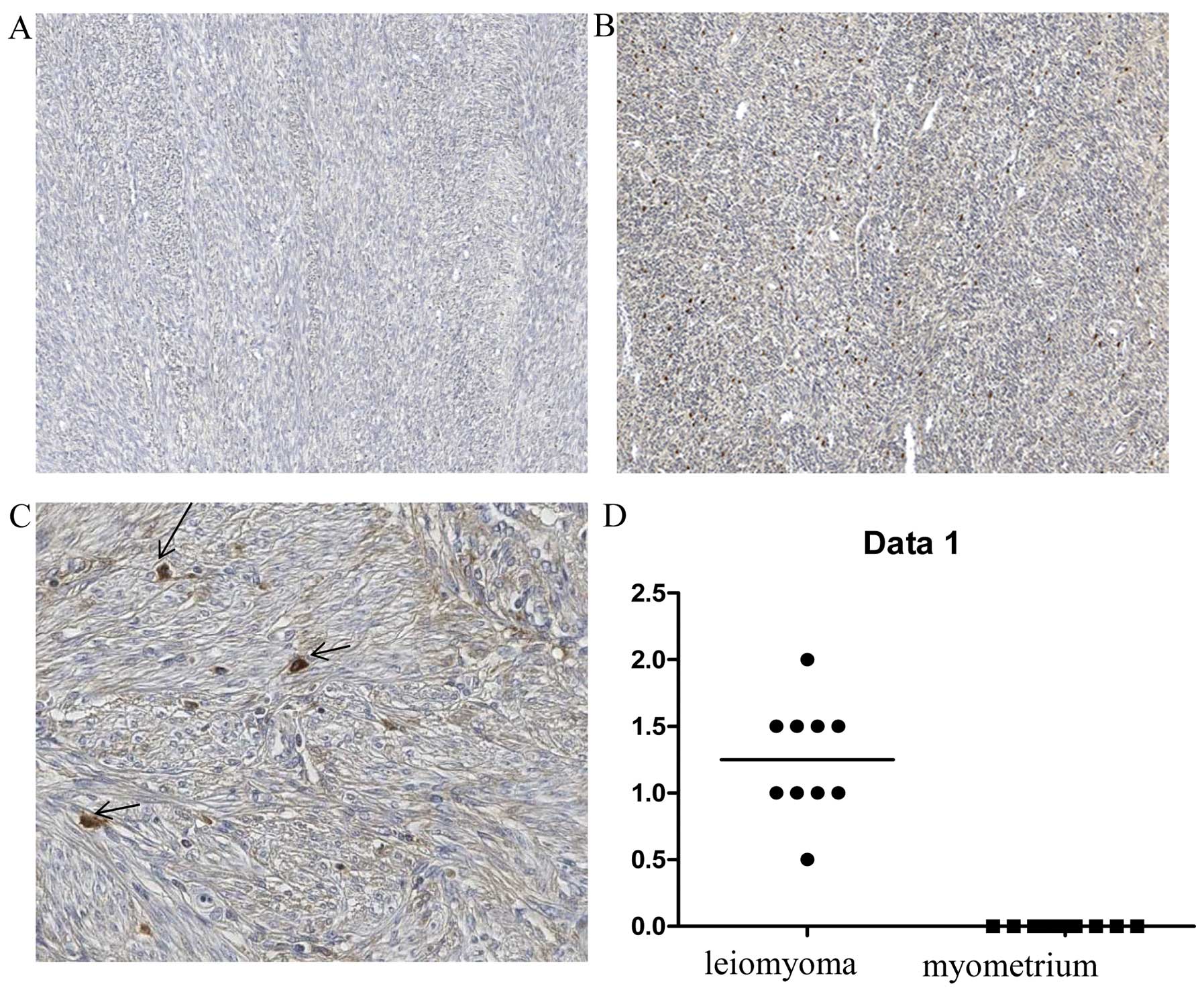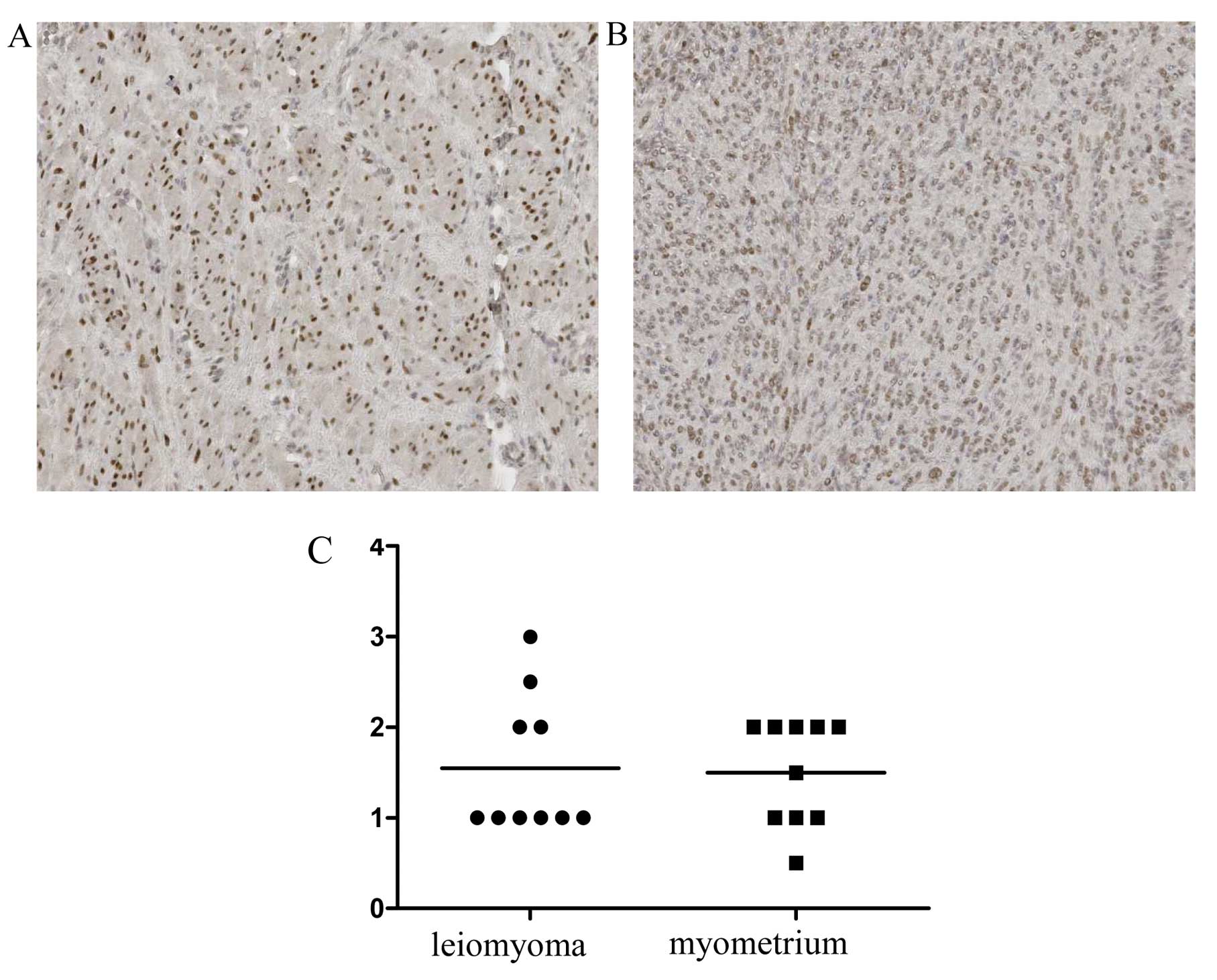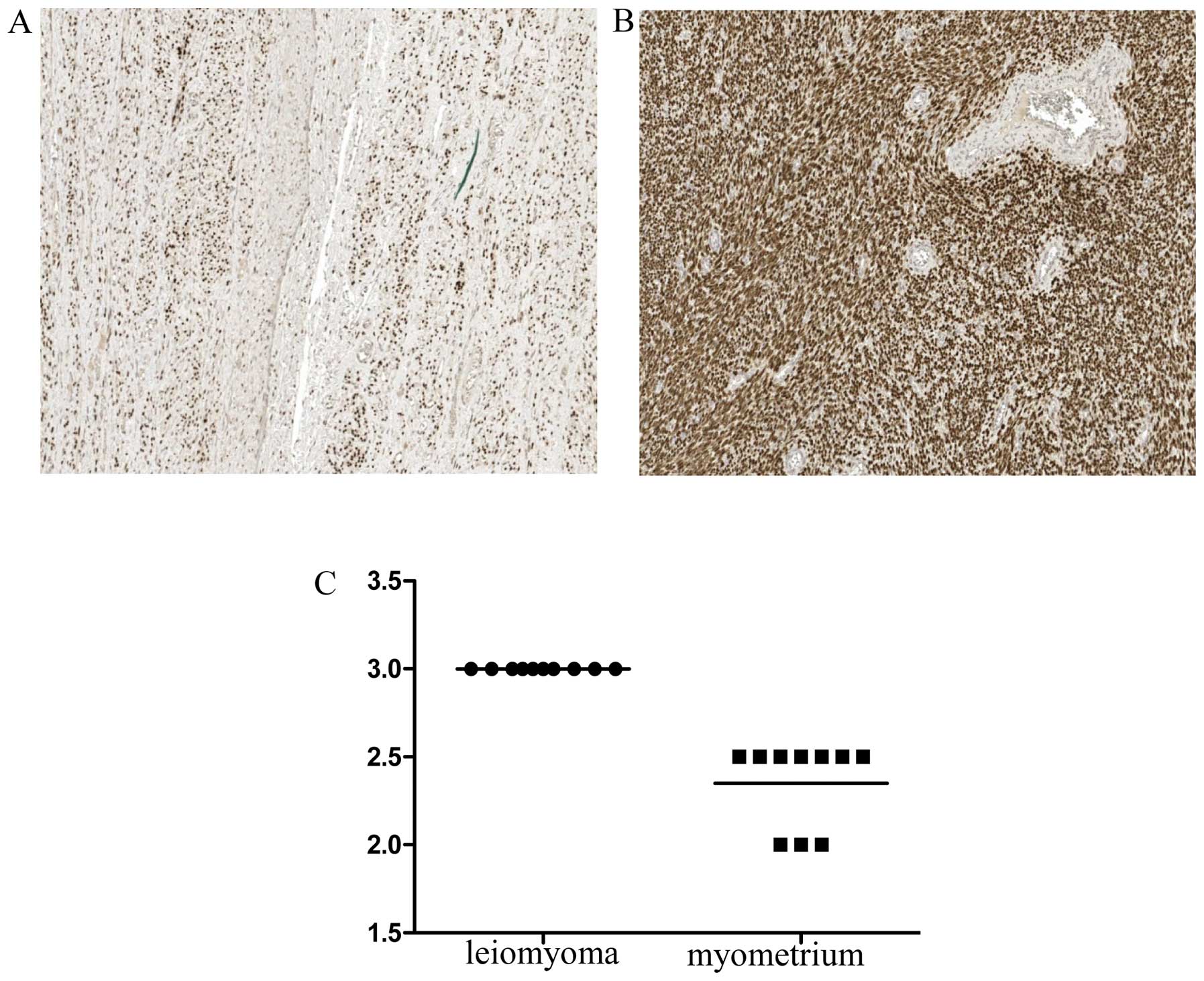|
1
|
Jacobson GF, Shaber RE, Armstrong MA and
Hung YY: Hysterectomy rates for benign indications. Obstet Gynecol.
107:1278–1283. 2006. View Article : Google Scholar : PubMed/NCBI
|
|
2
|
Lepine LA, Hillis SD, Marchbanks PA,
Koonin LM, Morrow B, Kieke BA and Wilcox LS: Hysterectomy
surveillance - United States, 1980–1993. MMWR CDC Surveill Summ.
46:1–15. 1997.PubMed/NCBI
|
|
3
|
Bernstein SJ, McGlynn EA, Siu AL, Roth CP,
Sherwood MJ, Keesey JW, Kosecoff J, Hicks NR and Brook RH: The
appropriateness of hysterectomy. A comparison of care in seven
health plans Health Maintenance Organization Quality of Care
Consortium. JAMA. 269:2398–2402. 1993. View Article : Google Scholar : PubMed/NCBI
|
|
4
|
Okolo S: Incidence, aetiology and
epidemiology of uterine fibroids. Best Pract Res Clin Obstet
Gynaecol. 22:571–588. 2008. View Article : Google Scholar : PubMed/NCBI
|
|
5
|
Chegini N, Ma C, Tang XM and Williams RS:
Effects of GnRH analogues, ‘add-back’ steroid therapy, antiestrogen
and anti-progestins on leiomyoma and myometrial smooth muscle cell
growth and transforming growth factor-beta expression. Mol Hum
Reprod. 8:1071–1078. 2002. View Article : Google Scholar : PubMed/NCBI
|
|
6
|
Wei T, Geiser AG, Qian HR, Su C, Helvering
LM, Kulkarini NH, Shou J, N’Cho M, Bryant HU and Onyia JE: DNA
microarray data integration by ortholog gene analysis reveals
potential molecular mechanisms of estrogen-dependent growth of
human uterine fibroids. BMC Womens Health. 7:52007. View Article : Google Scholar : PubMed/NCBI
|
|
7
|
Kim JJ and Sefton EC: The role of
progesterone signaling in the pathogenesis of uterine leiomyoma.
Mol Cell Endocrinol. 358:223–231. 2012. View Article : Google Scholar
|
|
8
|
Maruo T, Ohara N, Matsuo H, Xu Q, Chen W,
Sitruk-Ware R and Johansson ED: Effects of levonorgestrel-releasing
IUS and progesterone receptor modulator PRM CDB-2914 on uterine
leiomyomas. Contraception. 75:S99–103. 2007. View Article : Google Scholar : PubMed/NCBI
|
|
9
|
Ciarmela P, Bloise E, Gray PC, Carrarelli
P, Islam MS, De Pascalis F, Severi FM, Vale W, Castellucci M and
Petraglia F: Activin-A and myostatin response and steroid
regulation in human myometrium: disruption of their signalling in
uterine fibroid. J Clin Endocrinol Metab. 96:755–765. 2011.
View Article : Google Scholar :
|
|
10
|
Ciavattini A, Di Giuseppe J, Stortoni P,
Montik N, Giannubilo SR, Litta P, Islam MS, Tranquilli AL, Reis FM
and Ciarmela P: Uterine fibroids: pathogenesis and interactions
with endometrium and endomyometrial junction. Obstet Gynecol Int.
2013:1731842013.PubMed/NCBI
|
|
11
|
Norian JM, Owen CM, Taboas J, Korecki C,
Tuan R, Malik M, Catherino WH and Segars JH: Characterization of
tissue biomechanics and mechanical signaling in uterine leiomyoma.
Matrix Biol. 31:57–65. 2012. View Article : Google Scholar
|
|
12
|
Alenghat FJ and Ingber DE:
Mechanotransduction: all signals point to cytoskeleton, matrix, and
integrins. Sci STKE. 2002:pe62002.PubMed/NCBI
|
|
13
|
Paszek MJ, Zahir N, Johnson KR, Lakins JN,
Rozenberg GI, Gefen A, Reinhart-King CA, Margulies SS, Dembo M,
Boettiger D, Hammer DA and Weaver VM: Tensional homeostasis and the
malignant phenotype. Cancer Cell. 8:241–254. 2005. View Article : Google Scholar : PubMed/NCBI
|
|
14
|
Butcher DT, Alliston T and Weaver VM: A
tense situation: forcing tumour progression. Nat Rev Cancer.
9:108–122. 2009. View
Article : Google Scholar : PubMed/NCBI
|
|
15
|
Baronzio G, Schwartz L, Kiselevsky M,
Guais A, Sanders E, Milanesi G, Baronzio M and Freitas I: Tumor
interstitial fluid as modulator of cancer inflammation, thrombosis,
immunity and angiogenesis. Anticancer Res. 32:405–414.
2012.PubMed/NCBI
|
|
16
|
Gromov P, Gromova I, Bunkenborg J, Cabezon
T, Moreira JM, Timmermans-Wielenga V, Roepstorff P, Rank F and
Celis JE: Up-regulated proteins in the fluid bathing the tumour
cell micro-environment as potential serological markers for early
detection of cancer of the breast. Mol Oncol. 4:65–89. 2010.
View Article : Google Scholar
|
|
17
|
Lv J, Zhu X, Dong K, Lin Y, Hu Y and Zhu
C: Reduced expression of 14-3-3 gamma in uterine leiomyoma as
identified by proteomics. Fertil Steril. 90:1892–1898. 2008.
View Article : Google Scholar
|
|
18
|
Lin CP, Chen YW, Liu WH, Chou HC, Chang
YP, Lin ST, Li JM, Jian SF, Lee YR and Chan HL: Proteomic
identification of plasma biomarkers in uterine leiomyoma. Mol
Biosyst. 8:1136–1145. 2012. View Article : Google Scholar
|
|
19
|
Bertacco E, Millioni R, Arrigoni G, Faggin
E, Iop L, Puato M, Pinna LA, Tessari P, Pauletto P and Rattazzi M:
Proteomic analysis of clonal interstitial aortic valve cells
acquiring a pro-calcific profile. J Proteome Res. 9:5913–5921.
2010. View Article : Google Scholar : PubMed/NCBI
|
|
20
|
Gugliotta L, Bagnara GP, Catani L,
Gaggioli L, Guarini A, Zauli G, Belmonte MM, Lauria F, Macchi S and
Tura S: In vivo and in vitro inhibitory effect of alpha-interferon
on mega-karyocyte colony growth in essential thrombocythaemia. Br J
Haematol. 71:177–181. 1989. View Article : Google Scholar : PubMed/NCBI
|
|
21
|
Secchiero P, Sun D, De Vico AL, Crowley
RW, Reitz MS Jr, Zauli G, Lusso P and Gallo RC: Role of the
extracellular domain of human herpesvirus 7 glycoprotein B in virus
binding to cell surface heparan sulfate proteoglycans. J Virol.
71:4571–4580. 1997.PubMed/NCBI
|
|
22
|
Zauli G, Secchiero P, Rodella L, Gibellini
D, Mirandola P, Mazzoni M, Milani D, Dowd DR, Capitani S and Vitale
M: HIV-1 Tat-mediated inhibition of the tyrosine hydroxylase gene
expression in dopaminergic neuronal cells. J Biol Chem.
275:4159–4165. 2000. View Article : Google Scholar : PubMed/NCBI
|
|
23
|
Pavlou MP and Diamandis EP: The cancer
cell secretome: a good source for discovering biomarkers? J
Proteomics. 73:1896–1906. 2010. View Article : Google Scholar : PubMed/NCBI
|
|
24
|
Suehara Y, Kondo T, Fujii K, Hasegawa T,
Kawai A, Seki K, Beppu Y, Nishimura T, Kurosawa H and Hirohashi S:
Proteomic signatures corresponding to histological classification
and grading of soft-tissue sarcomas. Proteomics. 6:4402–4409. 2006.
View Article : Google Scholar : PubMed/NCBI
|
|
25
|
Bär H, Strelkov SV, Sjöberg G, Aebi U and
Herrmann H: The biology of desmin filaments: how do mutations
affect their structure, assembly, and organisation? J Struct Biol.
148:137–152. 2004. View Article : Google Scholar : PubMed/NCBI
|
|
26
|
Peddada SD, Laughlin SK, Miner K, Guyon
JP, Haneke K, Vahdat HL, Semelka RC, Kowalik A, Armao D, Davis B
and Baird DD: Growth of uterine leiomyomata among premenopausal
black and white women. Proc Natl Acad Sci USA. 105:19887–19892.
2008. View Article : Google Scholar : PubMed/NCBI
|
|
27
|
Wettschureck N and Offermanns S:
Rho/Rho-kinase mediated signaling in physiology and
pathophysiology. J Mol Med (Berl). 80:629–638. 2002. View Article : Google Scholar
|
|
28
|
Ren XD, Kiosses WB and Schwartz MA:
Regulation of the small GTP-binding protein Rho by cell adhesion
and the cytoskeleton. EMBO J. 18:578–585. 1999. View Article : Google Scholar : PubMed/NCBI
|
|
29
|
Kubota D, Mukaihara K, Yoshida A, Tsuda H,
Kawai A and Kondo T: Proteomics study of open biopsy samples
identifies peroxiredoxin 2 as a predictive biomarker of response to
induction chemotherapy in osteosarcoma. J Proteomics. 91:393–404.
2013. View Article : Google Scholar : PubMed/NCBI
|
|
30
|
Bae SM, Kim YW, Lee JM, Namkoong SE, Kim
CK and Ahn WS: Expression profiling of the cellular processes in
uterine leiomyomas: omic approaches and IGF-2 association with
leiomyosarcomas. Cancer Res Treat. 36:31–42. 2004. View Article : Google Scholar : PubMed/NCBI
|
|
31
|
Mesquita FS, Dyer SN, Heinrich DA, Bulun
SE, Marsh EE and Nowak RA: Reactive oxygen species mediate
mitogenic growth factor signaling pathways in human leiomyoma
smooth muscle cells. Biol Reprod. 82:341–351. 2010. View Article : Google Scholar :
|
|
32
|
Secchiero P and Zauli G:
Tumor-necrosis-factor-related apoptosis-inducing ligand and the
regulation of hematopoiesis. Curr Opin Hematol. 15:42–48. 2008.
View Article : Google Scholar
|
|
33
|
Zauli G, Melloni E, Capitani S and
Secchiero P: Role of full-length osteoprotegerin in tumor cell
biology. Cell Mol Life Sci. 66:841–851. 2009. View Article : Google Scholar
|
|
34
|
Karlisch C, Harati K, Chromik AM, Bulut D,
Klein-Hitpass L, Goertz O, Hirsch T, Lehnhardt M, Uhl W and
Daigeler A: Effects of TRAIL and taurolidine on apoptosis and
proliferation in human rhabdomyosarcoma, leiomyosarcoma and
epithelioid cell sarcoma. Int J Oncol. 42:945–956. 2013.PubMed/NCBI
|
|
35
|
De Vos WH, Houben F, Hoebe RA, Hennekam R,
van Engelen B, Manders EM, Ramaekers FC, Broers JL and Van
Oostveldt P: Increased plasticity of the nuclear envelope and
hypermobility of telomeres due to the loss of A-type lamins.
Biochim Biophys Acta. 1800:448–458. 2010. View Article : Google Scholar : PubMed/NCBI
|
|
36
|
Ragnauth CD, Warren DT, Liu Y, Mcnair R,
Tajsic T, Figg N, Shroff R, Skepper J and Shanahan CM: Prelamin A
acts to accelerate smooth muscle cell senescence and is a novel
biomarker of human vascular aging. Circulation. 121:2200–2210.
2010. View Article : Google Scholar : PubMed/NCBI
|
|
37
|
Kong L, Schäfer G, Bu H, Zhang Y, Zhang Y
and Klocker H: Lamin A/C protein is overexpressed in
tissue-invading prostate cancer and promotes prostate cancer cell
growth, migration and invasion through the PI3K/AKT/PTEN pathway.
Carcinogenesis. 33:751–759. 2012. View Article : Google Scholar : PubMed/NCBI
|
|
38
|
Li Q, Shi R, Wang Y and Niu X: TAGLN
suppresses proliferation and invasion, and induces apoptosis of
colorectal carcinoma cells. Tumour Biol. 34:505–513. 2013.
View Article : Google Scholar
|
|
39
|
Robin YM1, Penel N, Pérot G, Neuville A,
Vélasco V, Ranchère-Vince D, Terrier P and Coindre JM: Transgelin
is a novel marker of smooth muscle differentiation that improves
diagnostic accuracy of leiomyosarcomas: a comparative
immunohistochemical reappraisal of myogenic markers in 900 soft
tissue tumors. Mod Pathol. 26:502–510. 2013. View Article : Google Scholar
|
|
40
|
Yang C and Glass WF II: Expression of
alpha-actinin-1 in human glomerular mesangial cells in vivo and in
vitro. Exp Biol Med (Maywood). 233:689–693. 2008. View Article : Google Scholar
|
|
41
|
Otey CA and Carpen O: Alpha-actinin
revisited: a fresh look at an old player. Cell Motil Cytoskeleton.
58:104–111. 2004. View
Article : Google Scholar : PubMed/NCBI
|



